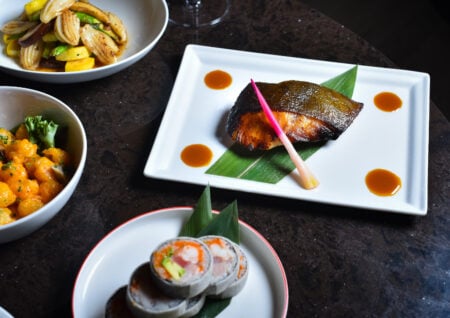Nobu Chooses Toronto’s Entertainment District for Its First Canadian Outpost


Featuring stunning interiors courtesy of Studio Munge
Toronto’s culinary landscape has been forever transformed with the highly anticipated opening of Nobu, the renowned luxury restaurant and hotel brand’s first location in Canada. Situated in the heart of Toronto’s bustling entertainment district, Nobu Toronto is a testament to the city’s growing reputation as a global dining destination.
Co-founded by legendary Japanese chef Nobu Matsuhisa, Academy Award-winning actor Robert De Niro and film producer Meir Teper, Nobu is celebrated worldwide for its innovative cuisine that blends traditional Japanese dishes with Peruvian ingredients. Lucky for us, the Toronto location continues this legacy, offering an array of signature dishes such as the iconic Black Cod with Miso and Yellowtail Jalapeño, alongside locally inspired creations exclusive to the Canadian market.
Nobu Toronto, designed by Studio Munge, captures the essence of Japanese-inspired design with Canadian craftsmanship. Spanning 10,000 square feet and accommodating 280 seats, the restaurant offers a dynamic sensory exploration across two levels.
Guests enter through Nobu Bar on the ground level, an intimate lounge with 57 seats in a dark, alluring atmosphere. The centerpiece is a 28-foot bronze chainmail Lasvit chandelier, imitating the drapery of a Japanese kimono, descending from the mezzanine. Handcrafted Kawara Japanese roof tiles adorn warmly lit pillars, enhancing the two-story high bar.
Upstairs, the mezzanine features a 20-seat sake bar and an intimate terrace, evoking serene urban Japanese gardens. Sure to be a hotspot during this year’s TIFF, the bar’s blue and white palette is inspired by Hokusai’s “The Great Wave off Kanagawa,” with Blue Tempest stone and hand-applied plaster curving across the ceiling.
The main dining area on the second level includes a 140-seat courtyard dining room made of blonde elm and a dark cherry wood private tasting room for 10. Circular timber beams with intricate Japanese joinery encircle a suspended light and porcelain art installation by Andrea Braescu, symbolizing a Japanese ginkgo tree.
An 11-seat sushi bar allows guests to engage with the sushi chefs, while a 22-seat private dining room, behind the chandelier and enclosed in bronze-tinted glass, offers a gallery view of the bar below.
Nobu Toronto promises an unparalleled dining experience with world-class cuisine, cutting-edge design, and exceptional hospitality. As the restaurant opens and the Nobu Hotel follows in Spring 2025, it marks a significant addition to Toronto’s culinary scene.

































